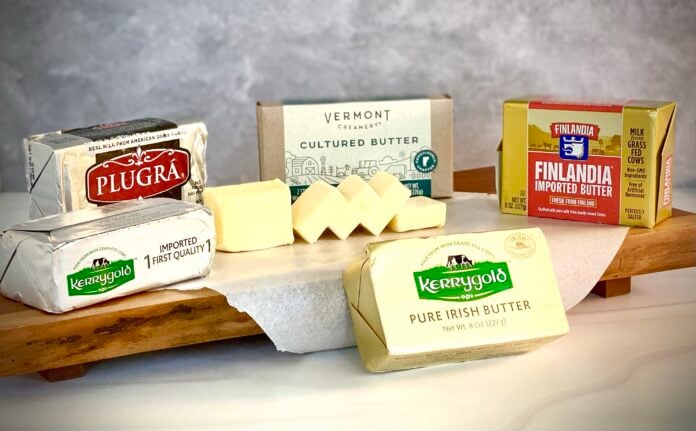Friends. I am the bona fide owner of a site called Begin with Butter, and I haven’t discussed butter. At all.
Let’s go ahead and chalk that up to being a rookie mistake. But it’s a rookie mistake that’s going to get fixed tuh-day.
Time for a deep dive into butter.

That actually sounds fun and delicious.
Isn’t it Just Butter? Why is This Important?
Excuse me while I curl into a fetal position and sob.
Butter is one of the most important elements in all of baking! It is one of the primary ingredients in almost all conventional baking recipes (and also in a huge number of savory baking recipes). It has an enormous ability to impact flavor, texture, and color in almost anything you bake.
If flavor, texture and color don’t matter to you, then I guess this isn’t for you (but I…have questions). If you want to improve those three elements of your baking, think of this post as your entrée into the rare air of exceptional home bakers and professionals the world over.
But no big deal. Totally your choice.
What, Exactly, is Butter?
Well, to start, butter is a fat. But it is SO. MUCH. MORE.
It’s commonly known that butter is a fat that adds a whole lot of flavor to whatever dish you’re making. But, in the baking world, butter is actually dissected all the way to its bare elements in order to decide which kind of butter is best for a specific recipe.
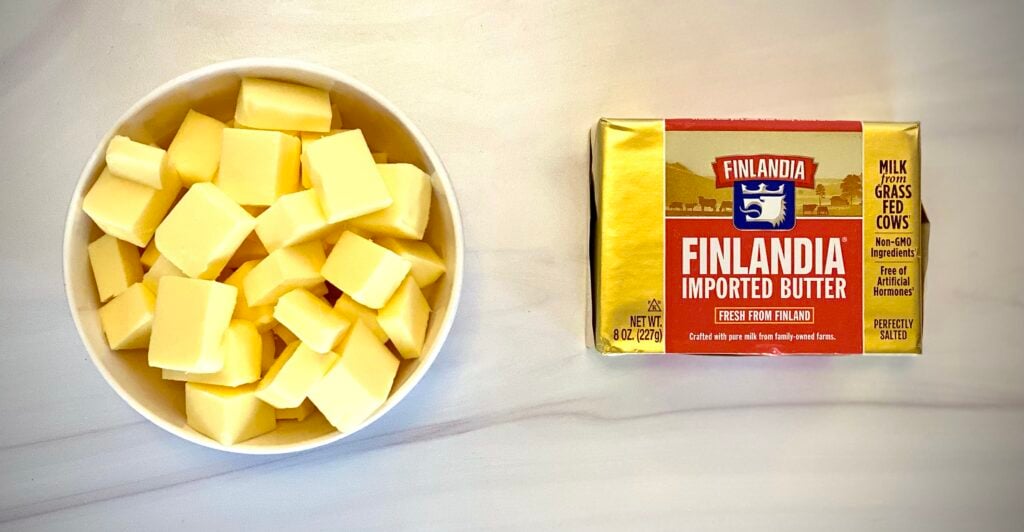
I can hear you now. “Sorry Shani, what?!”
Here’s the thing. Not all butter is created equal for baking use. Whether you’re making a flaky pie crust or a luscious lemon pound cake, the components of your butter make an enormous difference in your final product. Sometimes the butter itself is as important as any technique.
Let me say that again: there are times when an ingredient (in this case, the butter) is as important as any technique that you’re using in a recipe. In other words, you really want to have both of them in order to help a recipe reach its maximum potential.
So, what is butter? It’s a semi-solid emulsion, made from milk or cream, that contains butterfat, water, and some milk solids.
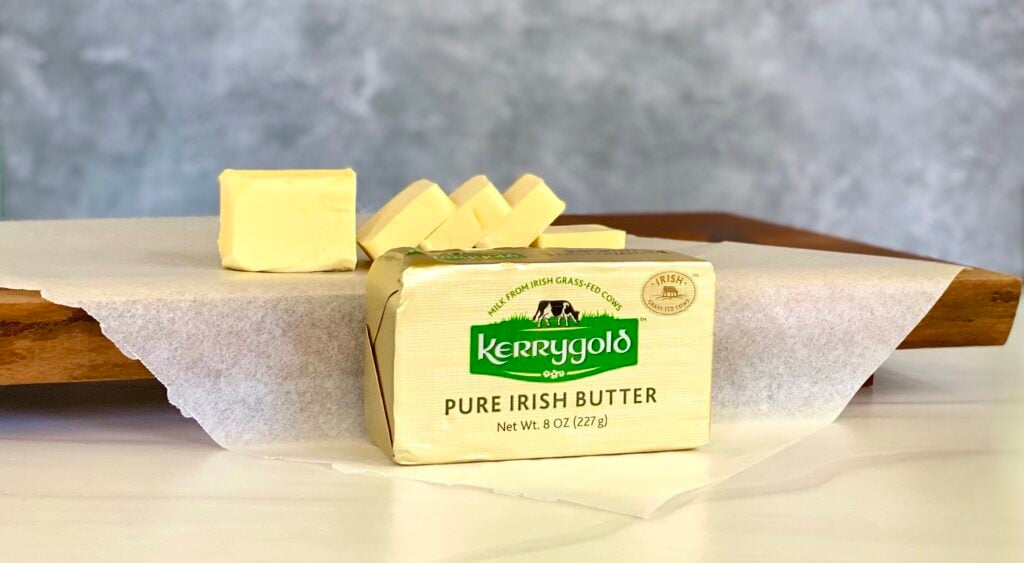
Saints. Saying that butter is an “semi-solid emulsion” is just a fancy way of saying that butter is not quite liquid and not quite solid. It’s somewhere in between and it’s composed of fat and liquid that can be separated from one another.
The fat content is key in butter. In the United States, in order to even qualify as “butter”, a product has to have at least 80% butterfat.
TL;DR version: Butter is a fat. So it contains a lot of fat.
American-Style Butter and European/ “European-Style” Butter.
American-style butter is most commonly known as “sweet cream butter”, and most American-style butters weigh in right at that 80% butterfat mark. Land O’ Lakes, a name that is synonymous with butter in the United States, sits exactly at 80%. Land O’ Lakes is the most famous of American-style butters and has been for generations; it’s actually the one that my mother used when I was growing up.
Not all “American-style” butters are American butters. Finlandia makes an excellent sweet cream butter and its butter is crafted in Finland.
European or “European-style” butters typically range from 82-83% butterfat, which leads to a much more distinct buttery flavor.
**note: when I say “European-style”, that just means that these are butters with at least 82% butterfat content that are not actually produced in Europe. A couple of examples of “European-style” butters are or Vermont Creamery (American) and Plugra (American).There is one other important distinction between American and European/European-Style butters that I’ll talk about more, below!**
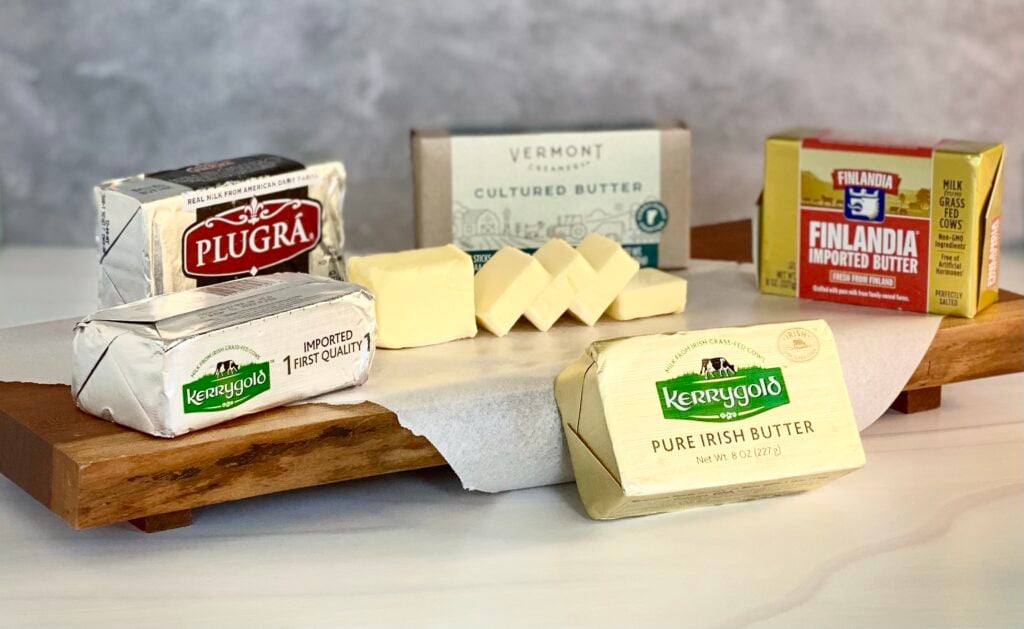
Some European/European-style butters can get as high as 86% butterfat. This next-level butterfat content is the glorious, gluttonous holy grail of butters and it’s meant to be slathered on warm, fresh artisan bread. This butter can be extremely hard to come by, but it’s worth the exorbitant price tag for a special occasion.

Butterfat?
Yes! Butterfat!
When milk or cream are churned, they separate into two main parts. Butterfat is the semi-solid element that separates from the liquid and is the main component in any butter.
The total difference between 80% butterfat Land O’ Lakes and 82% butterfat Vermont Creamery butter is actually much more than you’d think. Yes, baked goods with an 82% butterfat butter will be noticeably more buttery.
In addition, butter with a 2% higher butterfat content creates a softer texture for your cakes and adds a very noticeable golden color to your cookies.
Butter with a higher butterfat content also comes to room temperature more quickly for baking, since higher butterfat content means less water and that equals faster melt (this is a blessing for cakes and an absolute, soul-crushing, demoralizing curse for pies; you can overcome this with practice though.)
In short, when baking, less water and 82% butterfat takes your baked goods to the next level.
What is Cultured Butter?
Besides the butterfat content, the true distinction between traditional American and European/European-style butter, though, is that European/European-style butter is usually “cultured”. This does not mean that European/European-style butter has better manners and observes afternoon tea. This does mean that the milk or cream is infused with active cultures (bacteria) and allowed to ferment before churning, leading to a distinctly tangy flavor in the finished product.
Sweet cream butter (like Land O’ Lakes or Breakstone), on the other hand, is butter made from milk or cream and churned shortly after milking. Cultured butter is still butter from milk or cream, but with one distinctive difference: active cultures and time.
Active cultures are live bacteria that are added to milk and allowed to sit, or ferment, for a period of time. After that fermentation is done, then the milk is churned into butter. Since cultured butter is usually European/European-style butter, it’s typically churned longer than American butter in order to separate more fat from the water and achieve that higher butterfat content, in addition to that tangy je ne sais quois from the fermentation process.
My mouth is watering.
Salted vs. Unsalted?
To salt or not to salt…THAT, friends, is the question.
Salted butter is butter that has salt added during the churning process. The salt adds a bit of flavor and also serves as a preservative for the butter.
“Preservative” just means that natural salt helps butter last longer in the refrigerator case of your local grocer and in your refrigerator. I’m not talking about those preservatives that none of us can spell or say.
Unsalted butter is…butter without salt. Because it lacks salt, it doesn’t last as long on store shelves or in your refrigerator. Butter can be frozen in its original packaging, though, so if you find yourself doing bulk butter shopping, you won’t have to worry about this as much.
I cannot be the only person who does bulk butter shopping.
What I Use
In my experience, cultured and salted butter adds an unidentifiable umami to baking when it’s done correctly. This does take trial and error, though, so if you’re new to baking, I would recommend using an unsalted, cultured butter until you have developed your baking taste.
Baking with salted butter can be very rewarding, but it can quickly go wrong if you don’t remember to adjust the amount of salt in your recipe to accommodate for the salt in your butter. For beginners, this can be a lot to remember and a very frustrating experience.
My Recommendation for Baking
Like many things with baking, which butter you use is a personal preference. It’s my opinion that baked goods made with cultured, higher-butterfat butter taste noticeably better than baked goods made with sweet cream butter.
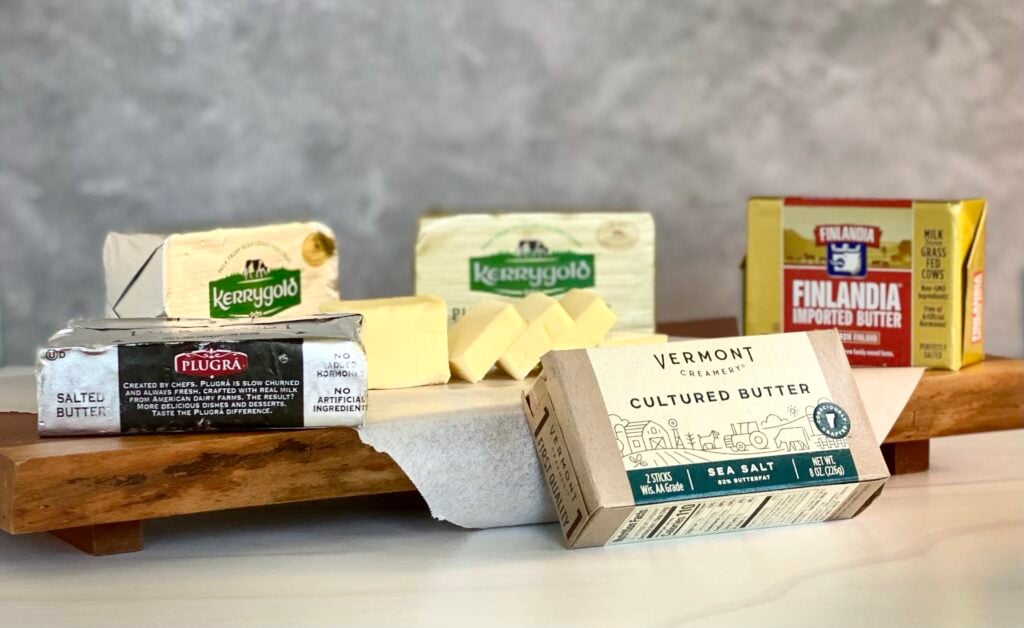
BUT
If the only thing available is sweet cream butter, by all means use it! I would never encourage someone to avoid the experience of baking because they didn’t have the right butter. That’s neither the purpose of this post nor is it the purpose of this blog. There are so many beautiful experiences that you can have during the baking process; I would never discourage anyone from baking because they didn’t have cultured European butter at their disposal.
We don’t do elitism here.
Plus, anything you make at home is going to taste much, much better than just about anything you can buy. I believe in you.
My Favorites.
This is the point where I get to wax poetic about my journey to my favorite butter.
I’ve tried a bunch of them since I really got started in 2013. Of course I began with what I knew (Land O’ Lakes), and then bounced around with some other brands before I discovered cultured European-style butter.
I have never looked back. I tried Plugra first, since my sister recommended it.
But Then…
I stumbled onto Trader Joe’s “Trader Jacques” brand and Saints I was changed. Trader Jacques doesn’t get the credit it deserves but that’s only because of the fact that it’s not widely available at other stores. If you are in Trader Joe’s and you have the opportunity to stock up on their butter, BUY IT ALL.
Unless, you know, they tell you that you can’t. Otherwise this is a strong buy. The looks from other patrons at checkout would totally be them appreciating your knowledge of fine French butter.
Trader Joe’s is pretty far from me, and I wanted something more accessible for my Cupcakes and Cocktails birthday party a few years ago (or at least something that could be delivered so I could avoid looking like a butter creep in the store). So, I went on a search to find another perfect butter.
After lots of internet research and a couple of trials, I found Kerrygold. Until May 2021, this was my absolute favorite butter; I just knew that it would stay that way for my entire baking career.
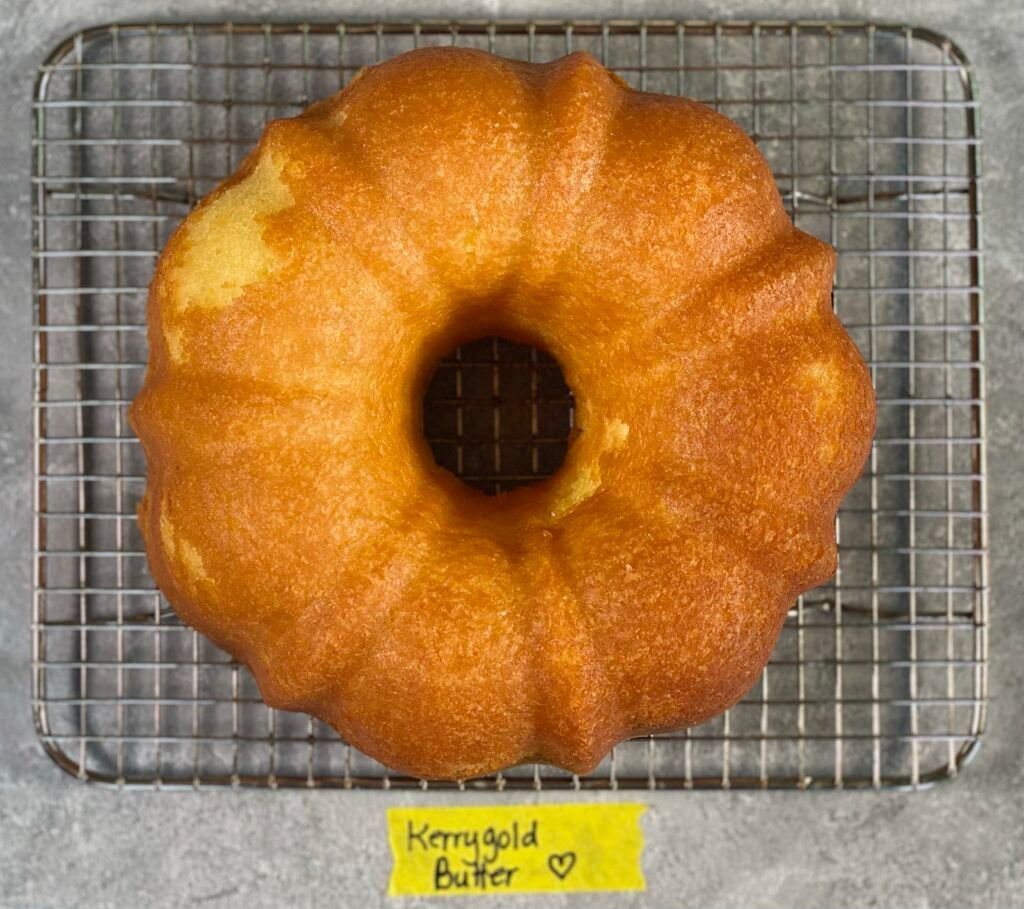
Kerrygold is an exceptional butter. It delivers a perfect crumb every single time. The color is so vibrant that it can actually look photoshopped in pictures. When I cut into a lemon pound cake, I get the most luscious and perfect aroma of butter. There’s nothing “wrong” with Kerrygold.
But Friends…
I’ve found a new favorite. And while I would still be happy to open a friend’s refrigerator and bake with whatever was in it, my own refrigerator is currently stocked with a butter whose color, flavor, and texture are second to none.
Currently, I prefer Vermont Creamery Cultured Butter with Sea Salt. The moment you open a stick of this butter, it’s crystal clear that you’re in for something very special. Right out of the box, the undeniable aroma (that of a very high quality, very fresh buttermilk) lets you know that this butter is way different than the others. For creaming butter and sugar, the 82% butterfat butter creams in recipes like an absolute dream.
The color of cakes and cookies is undeniably beautiful. And the silky texture that it creates in cakes in particular is unbelievable.
Whatever butter you choose, may you have incredible baking experiences and may you form many memories of laughing, hugging, and baking with your loved ones.
I hope you’ve found this post helpful! Don’t forget to subscribe while you’re here so that you can get notified with more helpful baking science tips!


